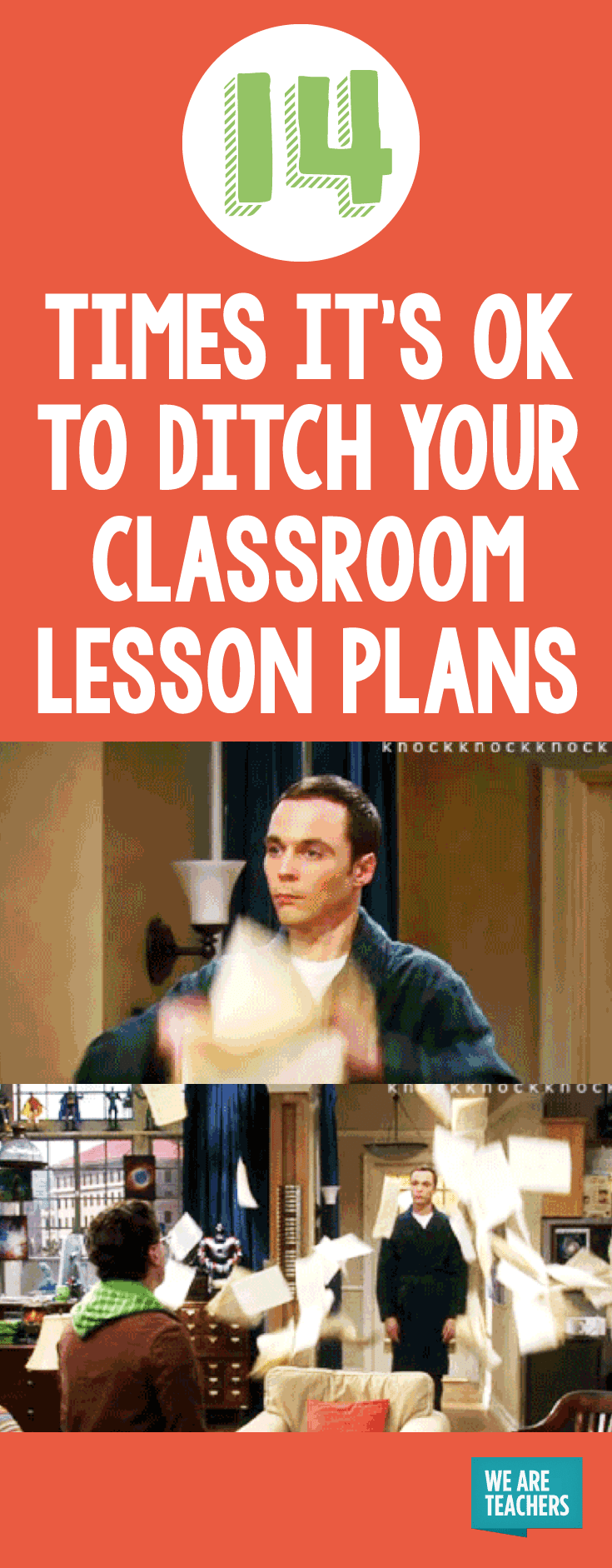The pressure teachers face to cover the curriculum and stick to our classroom lesson plans is real. With standardized testing, teacher evaluations, and ever increasing numbers of standards to teach the opportunities to break away from our plans often seem remote. It’s important to remember, however, that we’re in this for the kids, and with that in mind, here are 14 times its ok to ignore your lesson plans.
1. When the lesson just isn’t working.
We’ve all been there. It looks good on paper, but in your classroom it’s looking a lot more like a disaster. Don’t waste time continuing on with a plan that isn’t working. Drop it and find something that works!

2. When something else is working REALLY well.
You only budgeted 20 minutes for your students’ first Socratic seminar, but the kids are rocking it! Their questions are awesome, their responses thoughtful. Don’t be afraid to push the activity you had planned for the rest of the period back a day in order to let a lesson that’s going well run its course.

3. When a student says something really important (even if its off-topic).
Our students can’t learn if they don’t know we care. When a student says something that you know merits further discussion don’t push forward with your plan. Not only will your class get the impression that you’re more concerned with your lesson than your students, but the student who spoke might not be willing to do it again. It’s worth the 5-10 minute interruption to let your students know you’re listening.

4. When they just need a break.
You’re halfway through one of your more complicated lessons when you start to see that “checked out” look in your students’ eyes. You can finish the whole lesson this period if you push through, that’s what the lesson plan says. Don’t. We all know when our students’ brains have reached their capacity for the day. Tell them they deserve a break for all their hard work and they’ll be even more engaged for the second part of the lesson tomorrow.

5. When you’re unexpectedly ill.
Teaching is a profession unlike many others. From the moment the students enter to the moment they leave, we have very little “downtime.” We deal with this like champs most days, but when that migraine hits unexpectedly in the middle of math class, or the leftovers you ate at lunch decide they don’t like you during spelling, don’t be afraid to break from the routine. No child is going to fail at life because their teacher put on a few TED Talks while sitting quietly at their desk once or twice in a school year.

6. When a student truly needs you.
For some students, you might be one of only a few adults they trust so when a student comes to see you at an unexpected (and inconvenient) time or tells you in the middle of class they need to talk, make time. There is always a small task a class can do for 5-10 minutes while you check in with your student in need. You don’t have to be available for an hour, just letting them know that you’re there for them, and that they can come back to talk to you when you have more time might make all the difference in the world.

7. When you’ve made a mistake.
You’re halfway through a lesson when you realize you’ve been teaching something incorrectly, given out the wrong directions, told them something wrong. Stop. That lesson plan isn’t worth continuing. The students might be frustrated at the time they spent and the time they’ll have to spend learning the correct information, but seeing an adult willing to admit a mistake and walk them through how to fix it might turn out to be an even more valuable lesson.

8. When they’re sleepy.
It’s so tempting to push through a lesson even when a few students appear to be about ready to doze off (or, if you’re a secondary teacher, are actively snoozing in the back!). It’s their loss if they miss this information. I’m not wasting time on trying to keep them awake. But chances are, if you have a few students with droopy eyelids many more are feeling the same. A quick stand-and-stretch will get oxygen flowing back to their brains, give them a chance to refocus, and will make the rest of the lesson far more successful. It’s worth the loss of time to regain the attention of the learners.

9. When you learn a better/more interesting way to teach it.
Don’t stick with a plan just because you’ve taught it that way for years and it works well enough. It’s boring for them and for you. As educators, we have to be willing to take risks just like we ask our students to do in our classrooms. Try something new. Use a new app. Turn an individual project into a group project with more managed choices. Have the students teach each other. Just because something has worked well in the past doesn’t mean there might not be an even better way to teach it today. (And hey, if it fails…see #7!)

10. When you’re about to lose it.
It happens to most of us at least once a year. The students aren’t listening. You got a nasty email from a parent. There’s a faculty meeting tonight that you know is going to be pointless. You’ve taken away the fifth cellphone and the students don’t even seem to care. You’re about to blow your top. This is a great time to have a silly 10-minute plan that lets you walk away and just breathe. Let them solve some brain teasers in small groups. Put on a news story about a topic facing people their age and then tell them to debate it with the person sitting next to them. Anything that lets you regain your composure so you can take back control of the class.

11. When you need to start over.
A really important time to put the lesson plan aside is when you’ve lost control of the class. Maybe you were a bit too lax with classroom management in the beginning of the year, maybe you came in mid-way through and are dealing with the previous teacher’s mistakes, maybe the classroom chemistry is just tough. Whatever the reason, if you don’t have the students’ attention there is no point in trying to make it through your lessons. Take a day or two to go back to the beginning. Discuss the classroom culture with the class. Explain what you’d like it to look like and why. Ask them what they think you and they should do to improve things. Once you’ve come to an agreement on why they should listen to you and what will happen if they don’t, your lesson plans will be waiting.

12. When you find something amazing that you have to share.
Our students want to know who we are. Ok, in all honesty, they don’t really care about what we do when we’re not in school, but they do like to know that we’re human. We like some of the same things they do and we find the same sorts of things interesting or funny. Did someone show you a short clip on YouTube at lunch that made you snort with laughter? Take five minutes and show your next class. They’ll love getting a five minute break and getting a chance to see a more human side of their teacher.

13. When there’s something going on worth recognizing.
Take the time to recognize and discuss when something “big” is happening in the world. Many times, our students are vaguely aware of these events, but don’t have an adult they trust to explain it to them. They might have questions, concerns, or feelings about the topic that they haven’t had any place to discuss. This is our opportunity to branch outside our content to teach our students about listening skills, positive communication, the importance of knowing the facts before forming an opinion. These skills are all as valuable, if not more so, than whatever was on our lesson plan for the day.

14. When 10 minutes might change the way a student views themselves, each other, or the world.
Don’t ever be afraid to take time out to recognize a student for an outstanding achievement. Conversely, don’t avoid stopping what’s planned in class when a student says something that you know should be addressed. When a student brings up a controversial topic in a way that makes classmates (or you) uncomfortable, take the time to address the issue with the class in a fair but honest manner. Our students are watching us every day. They notice what we let slide and what we don’t. Take the time to show your students what issues and values are critical to be a kind and positive human being.

I want to hear from you, too! During what other times is it OK to set the lesson plans aside?


